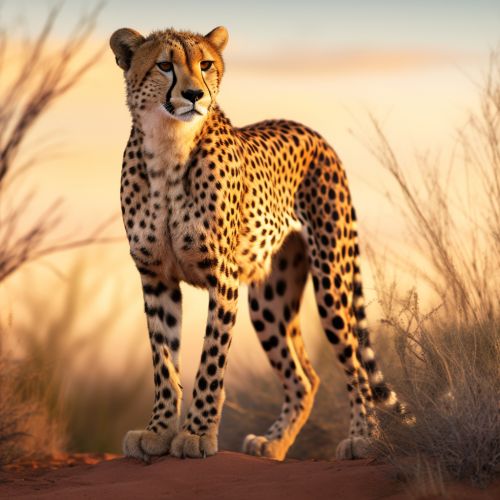Cheetah
Taxonomy and Evolution
The cheetah (Acinonyx jubatus) is a large felid that is native to Africa and parts of Iran. It is the only extant member of the genus Acinonyx. The cheetah's closest relatives are the puma and the Jaguarundi, with which it forms the Puma lineage, one of the eight lineages of Felidae. The Puma lineage diverged from the rest around 6.7 million years ago.
The cheetah likely evolved in Africa during the Miocene epoch (26 million to 7.5 million years ago), before migrating to Asia. Recent research has placed the last common ancestor of all existing populations as living in Asia 11,000 to 12,000 years ago, which may lead to revision and refinement of existing ideas about cheetah evolution.


Physical Characteristics
The cheetah is a sleek and powerful predator. It is characteristically known for its slender body and distinctive "tear marks" that stretch from the inner corners of its eyes down to the sides of its mouth. These marks help reflect the sun's glare and enable the cheetah to focus better on its prey. The cheetah's coat is typically tawny to creamy white or pale buff and is mostly covered with evenly spaced, solid black spots.
Adult males are slightly larger than females and have a slightly greater head-and-body length, with males measuring 112–150 cm (44–59 in) and females measuring 113–140 cm (44–55 in). The tail is even longer than the body, measuring 60–80 cm (24–31 in) in males and 60–77 cm (24–30 in) in females. The cheetah's weight can range from 21 to 72 kg (46 to 159 lb), though the average weight is between 40 and 60 kg (88 to 132 lb).
Speed and Hunting
The cheetah is renowned for its capability to reach tremendous speeds; it is often dubbed the fastest land animal, as it can reach speeds of up to 60–70 mph in short bursts covering distances up to 1,500 m (4,900 ft), and has the ability to accelerate from 0 to 60 mph in just a few seconds. This incredible speed is due to a combination of its strong and lightweight frame, long legs, and specialized muscles that function almost like the rubber band in a slingshot.
When hunting, cheetahs use their exceptional speed and agility to chase down and capture prey. They primarily prey on ungulates such as Thomson's gazelles and impalas. The high-speed chase often ends with the cheetah tripping its prey and delivering a suffocating bite to the neck.
Reproduction and Lifecycle
Cheetahs have a gestation period of approximately 90 to 95 days; the cubs are usually born in a secluded spot, where they are hidden in thick vegetation for protection. Litters can range from 3 to 5 cubs on average. The cubs are born with a downy underlying fur on their necks, called a mantle, which gives them a mohawk-type appearance; this fur is shed as the cheetah grows older.
Cheetah cubs face high mortality rates due to predation by other large carnivores, such as lions and hyenas, and perhaps genetic factors. At around 20 months, the mother leaves the cubs, who then form a sibling ("sib") group that will stay together for another 6 months. At about two years, the female siblings leave the group, and the young males remain together for life.
Conservation
The cheetah is listed as vulnerable on the IUCN Red List of Threatened Species. In 2016, the global cheetah population was estimated to be around 7,100 individuals in the wild. Major threats to the cheetah include habitat loss due to human encroachment, conflicts with humans, poaching, high susceptibility to diseases, and a decrease in prey.
Conservation efforts include captive breeding, habitat restoration, conflict mitigation, and raising awareness about the cheetah's plight. Several international organizations, including the Cheetah Conservation Fund and the International Fund for Animal Welfare, are working towards the conservation of the cheetah.
